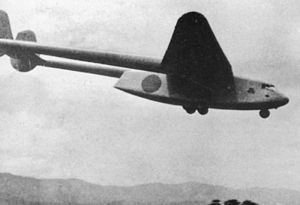Wingspan 35 m | Length 20 m | |
 | ||
The Kokusai Ku-7 Manazuru (真鶴 "white-naped crane"; Allied code-name Buzzard) was a large experimental twin boom Japanese military glider.
Contents
Design and development
An enlarged version of the earlier Maeda Ku-1 glider, it was developed during 1942. The use of a twin boom design allowed for a large square cargo door, which meant that the aircraft was capable of carrying either 32 soldiers, 7600 kg of cargo or even a light tank. It required a powerful towing aircraft, either the Nakajima Ki-49 or the Mitsubishi Ki-67, which were in short supply. As a result, the aircraft were modified by fitting them with engines, which were designated the Ki-105 Otori (鳳 "Phoenix"). Only nine were produced before development priorities were shifted elsewhere.
Variants
Specifications (Ku-7)
Data from Encyklopedia Uzbrojenia; Japanese Aircraft of the Pacific War
General characteristics
Performance
